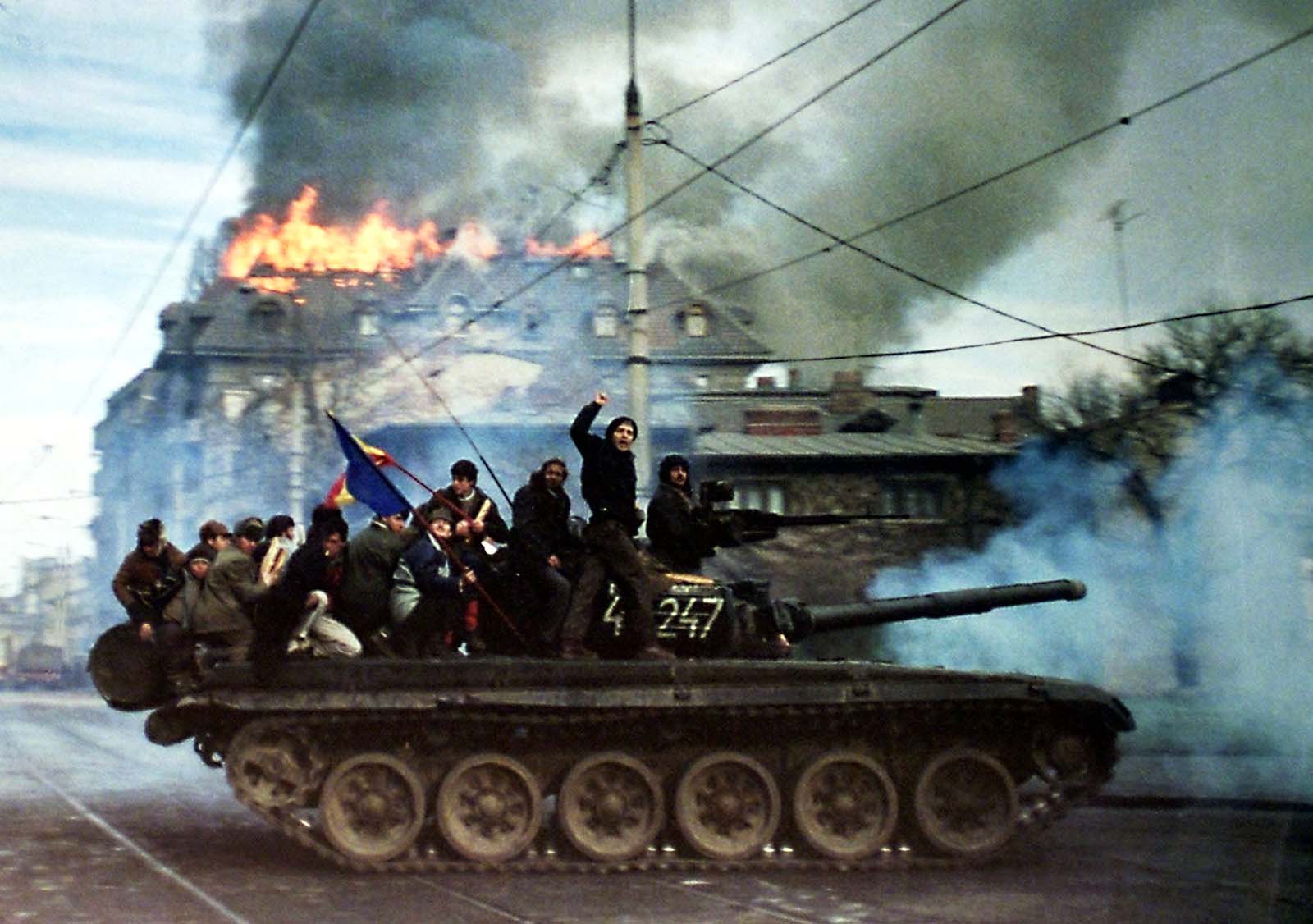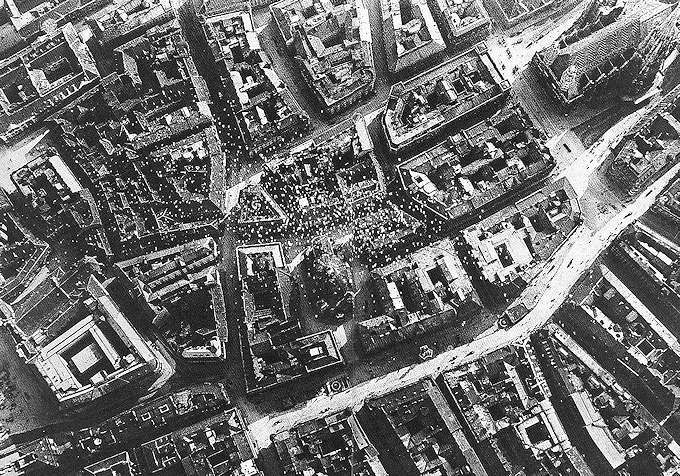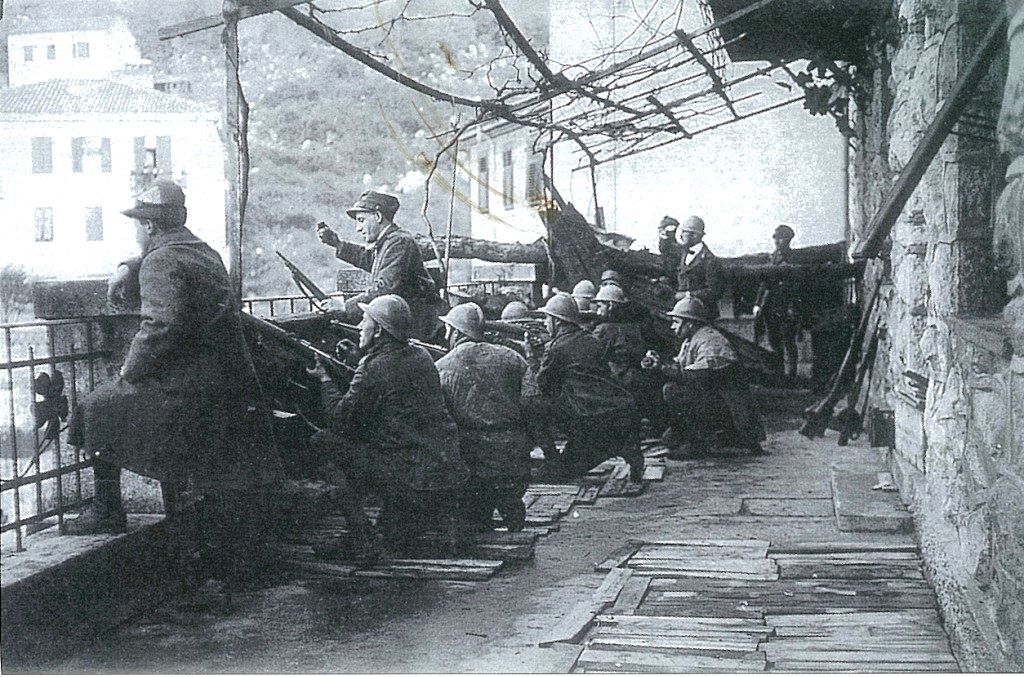I find it perfectly fitting that some states have declared a state of emergency for Christmas. Because for me, Christmas has always been a disaster to be avoided. Usually, I escaped by traveling to countries as devoid of Christmas as possible. This year, that’s not an option.
This year, we can only travel in memory. The last exciting Christmas was in 1989, thanks to the Romanians who, unlike the East Germans, put on a real revolution.

Yes, that’s the way to enjoy Christmas!
But today, we travel back in time even further, exactly one hundred years, to 24 December 1920. On that day, in order to avoid Christmas service and dinner at Grandma’s, some Italians started a small war. Against other Italians. In order not to accidentally break a piece of Italy in the process, they carried out the fighting on the other side of the Adriatic Sea. In a city that is now called Rijeka and is located in Croatia. At the time, the city was called Fiume and was located in, well, that was precisely the point of contention.
But first, a flashback: World War I. Italy was neutral because people were more enthusiastic about soccer than world politics. Only one poet and writer, Gabriele D’Annunzio, made flaming appeals for Italy to enter the war against Austria-Hungary. For one, because he considered life without war adventures hardly worth living. On the other hand, because Austria-Hungary had a few fillets on the eastern Adriatic, which D’Annunzio was eager to Italianize. After all, due to unfavorable geography, Italy did not yet have enough coastline.

The Italian king finally relented, and in 1915 Italy entered the war on the side of the Entente. D’Annunzio, who was not as young as he felt, but 52 years old, had no desire for the grueling mountain war. Instead, he sailed submarines into Austro-Hungarian ports and left cheeky messages in bottles. Then he trained as a pilot, flew behind enemy lines, even as far as Vienna in August 1918, where he dropped not bombs, but leaflets with his poems. That made the Austrians surrender, and D’Annunzio was a hero.

Italy was rewarded with South Tyrol and Istria and the assurance that at least one Italian restaurant would open in every town in Germany and Austria. But Rijeka, the pearl of the Adriatic, which the Italians call Fiume, was withheld from them and given a strange neutral status, similar to that of Danzig.
The people of Rijeka/Fiume didn’t really care, because they had already had a special status in the Habsburg Empire since 1779 and had gotten used to it. But D’Annunzio was furious: “What do we want with Trieste and all that stuff? The best čevapčići are in Rijeka!”
The Arditi, Italian stormtroopers, were furious as well, seeing themselves deprived of part of their hard-won victory. They elected D’Annunzio, already walking on a cane, as their leader and proposed the capture of Fiume.

That was in 1919. Because the people of Rijeka had read in the newspaper that the World War was over, they were not prepared at all. D’Annunzio was able to take the city on 12 September 1919 with about 2500 irregular forces.
But then came the big shock: Italy no longer wanted Fiume.
At least not in this way. Italy, always a stronghold of legality, insisted on respect for international law and preferred taking the path of negotiations in the League of Nations, a precursor to the United Nations, as well as with the newly formed Yugoslavia.
Now would have been the time to apologize (“Sorry, it was a snap reaction!”), return Fiume/Rijeka, go home and write books. But the little campaign had gone to the little man’s head. When Italy made it clear that D’Annunzio had no support to expect and even imposed a naval blockade on the friendly little town, D’Annunzio proclaimed a state of his own: The Italian Regency in the Kvarner Bay or, after the Italian name of the bay, the Italian Regency of Carnaro.
This republic is often seen as a blueprint for fascism. And indeed, if you watch the video above, you will recognize several aesthetic features that Mussolini and Hitler adopted later. In Carnaro there was a cult of leadership with daily speeches and parades. Prohibition of opposition. Corporations instead of parties. Organization of the people in mass organizations, as far as one can speak of masses in a small town. And whenever their leader marched past, the people had to shout “eia, eia, alala”.

On the other hand, anarcho-syndicalists, socialists, Dadaists, nudists, symbolists, futurists, as well as followers of yoga, cocaine, free love and verism gathered in Fiume. But also militarists and proto-fascists.
The newspaper “La Testa di Ferro – Giornale del Fiumanesimo” defined Fiumism on every front page: “An Italian Fiume – city of new life – liberation of all oppressed peoples, classes, individuals – spiritual instead of formal discipline – annihilation of all hegemonies, dogmas, conservatisms and parasitisms – the face of everything new -” and in a touch of self-irony “few words, many actions.”
The wild commune lived on smuggling and piracy. In between, there were orgies and torchlight processions. There was more happening in the small port town than in Babylon Berlin!

Only Italy couldn’t laugh about any of this. In November 1920, Italy and Yugoslavia concluded the Treaty of Rapallo (not to be confused with the German-Russian Treaty of Rapallo), according to which Fiume was to become an independent free state. D’Annunzio overreacted once again and declared war on Italy on 20 December 1920. Pretty brave for a city-state with 2500 soldiers.
And so it came to the “Bloody Christmas” of 1920, when Italian soldiers fought against former Italian soldiers. It started just in time for 24 December, and by 29 December Italy had taken the small republic. About 60 people had died in the fighting. And all of that because a writer had wanted to put his work on the big stage.

What happened to D’Annunzio? He fled from Fiume, oddly enough to the country he had just declared war on. There, he tried, apparently not lacking in self-confidence, to get a mandate from the king to form a government, thus forestalling Mussolini. But Mussolini had not only copied the fascist aesthetic from D’Annunzio, he had also learned that you simply have to create facts. In October 1922, Mussolini marched on Rome and took power.
D’Annunzio pandered to Mussolini, was richly rewarded financially, elevated to nobility, and given an extremely pompous villa. Yes, the amphitheater and the mausoleum on the hill are also part of it. And yes, that is a ship in the forest: the battleship Puglia. A stark contrast to the modest retirement home of Giuseppe Garibaldi, the real hero of Italian history.

To this day, a university and the airport in Brescia are named after D’Annunzio. Fascism doesn’t seem to ruin one’s reputation too much in Italy.
And what happened to Fiume? The Free State was founded, but already in March 1922, Italian fascists took control over it with a coup d’état. Basically, that was the trial run for the march on Rome. In January 1924, Italy formally annexed the city. In the end, the little war for Christmas turned out to have been a silly waste of lives.
Living in Rijeka in the 20th century, one could successively hold six different passports, without leaving the city once: those of Austria-Hungary, the Carnaro Republic, the Free State of Fiume, Italy (followed by German occupation), Yugoslavia and Croatia. This is just one reason why I find Rijeka a suitable choice for European Capital of Culture 2020. Unfortunately, the Corona pandemic intervened, but someday I will catch up on the visit. It’s better to explore capitals of culture before or after the hustle and bustle anyway.
Merry Christmas! Even if it is unlikely to be as interesting as it was a hundred years ago in Fiume.
So, this was the first episode in the new series “One hundred years ago …”. It was one of dozens of examples I could have picked to show that World War I did not end in November 1918. In fact, it continued in many places for several years. Sure, it was not the trench warfare anymore, but armed conflicts in “postwar” Europe cost more than 4 million lives and changed the map of the world until today.
Foolishly, I promised to deliver a new episode every month, but in January 1921 not so much seems to have happened. If you have any suggestions or ideas, let me know! If not, then let yourself be surprised by what I will dig up.
And if you learned something new, I appreciate your support for this blog. Thank you very much!
Links:
- All articles of the series “One Hundred Years Ago …”.
- More history.
- More reports from Italy and from Yugoslavia.
- Robert Gerwarth offers a good overview of the “post-war” years in “The Vanquished: Why the First World War Failed to End, 1917-1923”.
- Rijeka as Capital of Culture 2020.
- The D’Annunzio Museum.

Hi Andreas,
Interesting an ironic way to summarise the complexity of Italy post WW1 time…maybe a little bit too simplistic and let me allow to say sarcastic.
Just a couple of points:
3 years of WW1 conflict with 600,000 casualties was not enough to guarantee Italy what was promised: that war became known by the Italians as the mutilated victory.
Maybe you don’t recognize the secret London Pact. The ripped off feeling was wider spread in Italy than just by D’Annunzio an a few Arditi….and became unfortunately a strong basis for future nationalism sentiments.
Although D’Annunzio was for sure the voice of that feeling, he never had sympathy for Mussolini, and to identify him as a the father of fascism is in my opinion wrong.
BTW according Italian law 645/1952 nothing linked to fascism is allowed to be celebrated.
For me and probably for the majority of italians, D’Annunzio is proudly remembered as the “Vate”, simply according the Latin concept.
Merry Christmas
Hello Daniel,
thank you very much for your comments!
Indeed, as almost always on this blog, I have approached the subject with irony and sarcasm. And in this series, I am going to try to introduce events that are new to most or at least many readers, so I cannot go into the last detail (which I often don’t know myself). The main point of this episode was less on D’Annunzio or Italy, but on pointing to the conflicts that lasted well beyond armistice or the Paris treaties that officially ended World War I. Compared with many other conflicts (e.g. the Polish-Russian War, the Irish War of Independence, the war between Greece and Turkey), this seemed to be an episode which could be addressed with a little bit more humor.
I was well aware of the > 600,000 Italian military casualties in World War I, although I was shocked by the equal number of civilian losses in Italy – source: http://www.centre-robert-schuman.org/userfiles/files/REPERES%20-%20Modul%201-1-1%20-%20Notiz%20-%20Bilanz%20in%20Ziffern%20des%20Ersten%20Weltkrieges%20-%20DE.pdf , page 4 -. How did that happen?
And yes, I was aware of the London Pact from 1915, although that pact excludes the bay of Fiume.
But the larger problem with that pact is that it was one at the expense of a third party. A and B can sign pacts about the territories of C as much as they want, but such pacts don’t bind C. “Pacta tertiis nec nocent nec prosunt”, as you would say.
Maybe that was one reason why the parties to the 1915 London Pact kept it secret.
And then, it was simply overtaken by history. In 1915, nobody (or at least not many) imagined that there would be a new country, the Kingdom of Serbs, Croats and Slovenes, which would soon become Yugoslavia. And in 1915, the concept of “self-determination of the peoples” was not yet the guiding principle of post-war order, which it would become from 1918 on.
What is more important and what I should have mentioned in the article is not to think of Fiume as a Croatian or Yugoslav town just because it is located there now. I don’t know the exact proportions, but I think a considerable portion, maybe even the majority, of people in Fiume regarded themselves more as Italians than as Yugoslavians. (Although it’s generally tricky to bestow national identities on people in retrospect because people often used to identify more with a territory than with a country, especially in ‘proud’ and ‘historic’ places like Fiume or Ragusa, which had enjoyed some independence or special status.)
I also would not portray D’Annunzio as the “father of fascism”, as the Regency of Carnaro was probably more of a hotchpotch of ideas. (It didn’t last long enough to know what direction it would have taken.) But there were many elements that fascism copied.
And while there was a personal rivalry between D’Annunzio and Mussolini (hard to imagine that there wouldn’t have been, with two such large egos), D’Annunzio did support the fascist conquests and Italian expansion. An expansion, which you can’t have without the killing or subjugation of other peoples. And that, for me, is enough reason to be more critical of D’Annunzio. (Although it would have been great if he had been successful in his attempts to convince Mussolini not to align with Hitler.)
Buon natale!
By the way, this article got me seriously interested in visiting “Il Vittoriale”. Have you been there?
And are some of D’Annunzio’s books still read, or is he mainly remembered as a political/historical figure?
Not off topic by much, have you ever walked one of the remembrance trails in the mountains? I’ve long been interested in that because it’s one of the forgotten fronts (forgotten outside of Italy and maybe Austria, that is) of World War I.
I enjoy combining long walks with historical research – as I did this summer on the King Ludwig Trail in Bavaria: https://andreasmoser.blog/tag/king-ludwig-trail/ -, but I am not sure if I am up to it. I am fit and used to mountains, but as soon as there is a “via ferrata”, it gives me the creeps.
Goodness, that’s a nice little Villa and gardens. And a battleship too?
Fascism is still alive and thriving, or trying to thrive.
Don’t relatives always fight at Christmas?😉🎄 I hope yours is peaceful. Mine, is thankfully over. A day early because we could🤷🏼♀️😂
I completely ignored Christmas and, as a precautionary measure, turned off my phone. :-)
And next year, I hope I’ll be cat-sitting again – maybe in an Italian villa, similar to that of D’Annunzio.
Hi Andreas,
Thanks for taking the time to clarify, and indeed blogs – by their nature – have limitations.
I must admit your comment about identification by a territory rather than by a country is so true, even more so today: a territory is defined, while a country is a mutable political entity…my grand parents could never really connect themselves with a country but very easily identified themselves as Alsatians.
The Vate was indeed part of my last gymnasium’s year curriculum, about 40 years ago in Tuscany.
As you can imagine D’Annunzio is for sure remembered more for his books and for his adventurous “lifestyle” rather than for his political/historical background: potentially controversial. BTW he was greatly influenced by Nietzsche “Übermensch” idea, becoming a soldier quite late in his life, when he was already a world star. The “Vittoriale” summarise the ego of this “Poeta-Eroe”: a must seen place, visited many years ago.
On a different note, I was recommended many times the Walk of Peace in the Soča Region Foundation (Alps to the Adriatic). Yet, still on my to do list, so can’t comment.
I read about your King Ludwig Trail: an amazing discovery for me, despite my father was from Kempten Allgäu…and BTW is Bavaria Germany?
Oh, I think you would love the King Ludwig Trail, too. It was such a beautiful walk, not too strenuous.
I have been looking at the Walk of Peace, and I am already intrigued. That seems to be not too hard of a walk, with plenty of museums, and I love that Slovenian-Italian region (although I have only been to the coast so far: Piran, Portoroz, Koper).
Alsace is the perfect example for what I meant.
Bavaria, oddly enough, has also maintained its regional identity, although it has undisputedly been part of Germany since 1871 and there is really no independence movement to speak of – https://andreasmoser.blog/2017/11/27/bavaria/ .
Maybe Bavaria could best be compared to Texas. It’s part of the union, but it wants everybody to know that it’s bigger and better than everyone else. And everyone else is slightly annoyed by it.
If you look at all the things that allegedly make Bavaria special, you can unpick them one by one and see that they are not: Other states in Germany are predominantly Catholic as well. Other states were independent kingdoms as well. Other states have beautiful castles as well. Et cetera.
But in Bavaria, a lot of people really believe that everything is better there. Often, they don’t bother to venture to any other part of Germany, believing that there can’t possibly be anything of interest.
I myself don’t have a particular Bavarian identity, probably because the mainstream image of Bavarians as beer-drinking farmers doesn’t suit me at all. For example, I try to speak in High German instead of Bavarian on purpose.
Curiously, only in Austria do I say that I am from Bavaria instead of Germany, because I feel that I am accepted more as a close relative than a distant overbearing one.